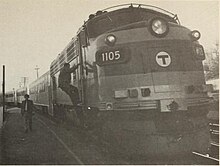 Global Information
Global InformationHistory of the MBTA information



The history of the Massachusetts Bay Transportation Authority (MBTA) and its predecessors spans two centuries, starting with one of the oldest railroads in the United States. Development of mass transportation both followed existing economic and population patterns, and helped shape those patterns.
Privately owned mass transit in the Boston area evolved from the colonial period into the early 1900s, including ferries, steamships, steam commuter railroads, horse and electric streetcars, elevated railways, and subways. Many streetcar lines were consolidated into the West End Street Railway in 1887. This was merged into the Boston Elevated Railway in 1897, which that same year opened the first subway in the United States (the Tremont Street subway). Subway construction was funded by city taxpayers, and overseen by the new Boston Transit Commission. As automobiles started causing financial problems for mass transit operators, the MTA took over the BER in 1947 and began replacing inner commuter rail service with rapid transit expansions. The MTA started running ferry services in 1963. The MBTA replaced the MTA in 1964, expanding the service area to fully include the area's commuter rail services, all of which had to be taken over by the government or discontinued for financial reasons. Paratransit services began in 1977.
Except for the Mattapan Trolley and some portions of the Green Line, all streetcars were replaced by buses. The MBTA benefitted from a political turn away from highway construction in the 1970s, which resulted in relocation of part of the Orange Line. In the following decades, demand for mass transit services increased as the population migration out of the urban core toward the car-centric suburbs reversed, and overall population kept increasing.
The agency continued expanding and reactivating commuter rail services, and expanding rapid transit into the late 20th and early 21st century. The Big Dig (1991-2006) resulted in the creation of the Silver Line subway-busline and other promised expansions to mitigate the increased pollution caused by increased highway capacity (required after a Clean Air Act lawsuit by the Conservation Law Foundation). In 2000, the state changed the MBTA financing mechanism from habitually paying expenses in arrears to getting a fixed budget: 1% of state retail sales (out of a total 5% statewide sales tax at the time) plus assessments from cities and towns in the service area. Partly due to an increase in ecommerce, sales tax revenues were lower than expected, and because debt service for the Big Dig transit projects had been allocated to the MBTA, the agency experienced financial problems that required occasional supplemental state funding. It became a division of the newly consolidated MassDOT in 2009. During the term of Governor Charlie Baker (2015-2023), deferred subway system maintenance from the period of austerity became problematic. A 2015 snowstorm shut down two subway lines, resulting in temporary appointment of a Fiscal and Management Control Board. During the recovery from the COVID-19 pandemic, an accumulation of high-profile safety incidents resulted in a Federal Transit Administration investigation in 2022, and sudden safety-related service cuts.